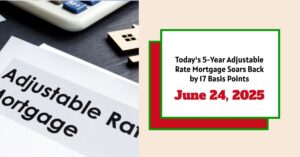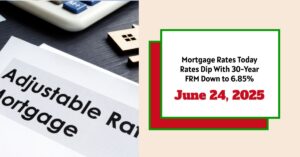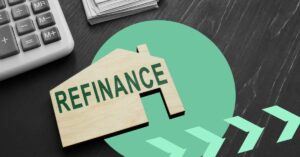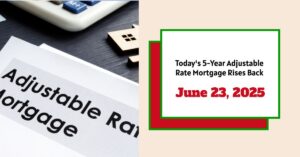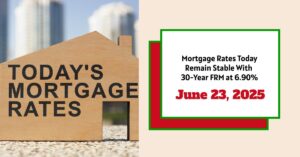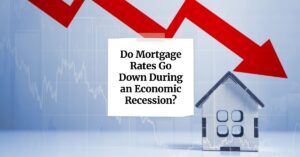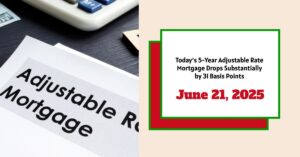Mortgage rates can feel like a rollercoaster, and understanding the options can be overwhelming. As of today, June 24, 2025, the national average 5-year Adjustable Rate Mortgage (ARM) rate stands at 7.25%. This article will explore what that means for you, diving deep into the pros and cons of a 5-year ARM, and helping you decide if it's the right path to homeownership or refinancing.
Today's 5-Year Adjustable Rate Mortgage Soars by 17 Basis Points – June 24, 2025
Buying a home is a huge decision, and choosing the right mortgage is just as critical. You've probably heard about fixed-rate mortgages, but Adjustable Rate Mortgages (ARMs) offer something different. Let's be honest, the mortgage world can be confusing. It's tempting to just grab the first option that seems reasonable, but understanding the nuances – especially with ARMs – can save you serious money and stress in the long run. I've seen firsthand how borrowers who take the time to understand their options end up in a much better financial situation.
What Exactly is a 5-Year ARM?
A 5-year ARM is a type of mortgage where the interest rate is fixed for the first five years and then adjusts periodically, usually once a year, based on prevailing market conditions.
Here's the breakdown:
- Fixed-Rate Period: For the first five years, you'll enjoy the stability of a fixed interest rate and consistent monthly payments. This is the “honeymoon” phase!
- Adjustment Period: After the initial five years, your interest rate will adjust based on an index, such as the Secured Overnight Financing Rate (SOFR) plus a margin (a fixed percentage added by the lender).
- Rate Caps: ARMs typically have rate caps that limit how much the interest rate can increase at each adjustment period and over the life of the loan. These caps offer some protection against drastic rate hikes.
Current Mortgage Rate Snapshot: June 24, 2025
Before we delve deeper into 5-year ARMs, let's take a look at where the broader mortgage market stands today:
| Loan Program | Rate | 1 Week Change | APR | 1 Week Change |
|---|---|---|---|---|
| 30-Year Fixed Rate | 6.83% | Down 0.08% | 7.29% | Down 0.08% |
| 20-Year Fixed Rate | 6.51% | Down 0.07% | 7.01% | Up 0.06% |
| 15-Year Fixed Rate | 5.87% | Down 0.09% | 6.17% | Down 0.09% |
| 10-Year Fixed Rate | 5.85% | Down 0.08% | 6.04% | Down 0.03% |
| 7-Year ARM | 7.44% | 0.00% | 8.02% | Up 0.20% |
| 5-Year ARM | 7.25% | Up 0.17% | 7.85% | Up 0.17% |
| 3-Year ARM | — | 0.00% | — | 0.00% |
Source: Zillow
Why Consider a 5-Year ARM? Weighing the Pros
Even though the rates are higher than the 30 year and 15 year fixed, there are some valid reasons for using these ARMs.
- Lower Initial Interest Rate: Historically, 5-year ARMs often start with a lower interest rate compared to 30-year fixed-rate mortgages. While today's rate of 7.25% is higher than the 30-year fixed-rate of 6.83% and 15-year fixed rate of 5.87% the difference sometimes can be a financial draw.
- Potential Savings: If interest rates remain stable or decrease during the initial fixed-rate period and beyond, you could save money on interest payments over the life of the loan.
- Flexibility: A 5-year ARM can be a good option if you plan to move or refinance within five years. You're not locked into a long-term commitment at a higher rate if rates were to drop.
- Investment Opportunities: The potential savings from a lower initial rate could be invested elsewhere, potentially generating a higher return than the interest saved.
The Other Side of the Coin: The Cons of a 5-Year ARM
It's not all sunshine and roses. There are risks involved:
- Interest Rate Risk: The biggest risk is that interest rates could rise after the fixed-rate period ends, leading to higher monthly payments.
- Complexity: ARMs can be more complex than fixed-rate mortgages, making it harder to understand the potential risks and benefits.
- Uncertainty: Predicting future interest rates is nearly impossible. You could be gambling on market conditions.
- Refinancing Risk: If interest rates rise significantly, refinancing might not be an option, leaving you stuck with a higher rate.
Recommended Read:
What Was 5-Year Adjustable Rate Mortgage on June 23, 2025?
Fixed vs. Adjustable Rate Mortgage in 2025: Which is Best for You?
Who Should Consider a 5-Year ARM?
A 5-year ARM might be a suitable option for you if:
- You Plan to Move Soon: If you anticipate moving within the next five years, you can take advantage of the lower initial rate without worrying about long-term rate adjustments.
- You Expect Your Income to Increase: If you expect your income to increase significantly in the coming years, you might be able to absorb potential rate increases.
- You're Comfortable with Risk: If you're comfortable with the possibility of rising interest rates and higher monthly payments, a 5-year ARM could be a good option.
- You Have a Solid Financial Plan: Make sure you have a plan B in case you have to refinance.
Factors Influencing ARM Rates
Several factors influence 5-year ARM rates:
- Federal Reserve Policy: The Federal Reserve's monetary policy decisions, particularly its decisions on interest rates, have a significant impact on mortgage rates.
- Economic Growth: A strong economy typically leads to higher interest rates, while a weak economy can lead to lower rates.
- Inflation: High inflation can push interest rates higher as lenders demand a higher return to compensate for the erosion of purchasing power.
- Global Events: Global events, such as political instability or economic crises, can also influence mortgage rates.
What to Ask Your Lender
If you're considering a 5-year ARM, be sure to ask your lender these crucial questions:
- What is the index used to determine the interest rate adjustment?
- What is the margin added to the index?
- What are the rate caps (both periodic and lifetime)?
- How often will the interest rate adjust?
- What is the worst-case scenario for my monthly payments?
5-Year ARM vs. Other Loan Types: A Quick Comparison
To make a better decision, let's compare the 5-year ARM to other common mortgage options:
| Loan Type | Interest Rate | Payment Stability | Risk Level | Best For |
|---|---|---|---|---|
| 5-Year ARM | Initially Lower | Fixed for 5 years, then adjusts | Moderate | Those planning to move or refinance within 5 years, comfortable with some risk |
| 30-Year Fixed | Higher | Fixed for 30 years | Low | Those seeking payment stability and long-term security |
| 15-Year Fixed | Lower | Fixed for 15 years | Low | Those who want to pay off their mortgage quickly and save on interest, but can afford higher monthly payments |
My Personal Take: Proceed with Caution
In my experience, 5-year ARMs can be a useful tool, but they're not for everyone. I always advise potential borrowers to carefully assess their risk tolerance, financial situation, and long-term plans before opting for an ARM. Understand the math and don’t get seduced by the lower initial rate if you are not confident about handling future adjustments.
Conclusion:
Deciding whether or not to choose a 5-year ARM on June 24, 2025, or any other day for that matter, depends entirely on your individual circumstances. Weigh the pros and cons, understand the risks, and seek advice from a qualified mortgage professional. Armed with knowledge, you can make a confident decision that aligns with your financial goals.
Capitalize on ARM Rates Before They Rise Even Higher
With fluctuating adjustable-rate mortgages (ARMs), savvy investors are exploring flexible financing options to maximize returns.
Norada offers a curated selection of ready-to-rent properties in top markets, helping you capitalize on current mortgage trends and build long-term wealth.
HOT NEW LISTINGS JUST ADDED!
Connect with an investment counselor today (No Obligation):
(800) 611-3060
Also Read:
- Will Mortgage Rates Go Down in 2025: Morgan Stanley's Forecast
- Expect High Mortgage Rates Until 2026: Fannie Mae's 2-Year Forecast
- Mortgage Rate Predictions 2025 from 4 Leading Housing Experts
- Mortgage Rates Forecast for the Next 3 Years: 2025 to 2027
- Will Mortgage Rates Ever Be 3% Again in the Future?
- Mortgage Rates Predictions for Next 2 Years
- Mortgage Rate Predictions for Next 5 Years
- Mortgage Rate Predictions: Why 2% and 3% Rates are Out of Reach
- How Lower Mortgage Rates Can Save You Thousands?
- How to Get a Low Mortgage Interest Rate?
- Will Mortgage Rates Ever Be 4% Again?
